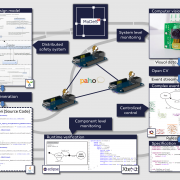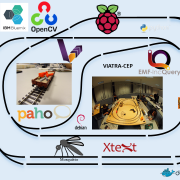Third price at the Eclipse Open IoT Developer Challenge
The Open IoT Developer Challenge is an annual challenge organized by the Eclipse IoT Working Group of EclipseCon North America and sponsored by bitreactive, Eurotech, MicroEJ, Red Hat, and Zolertia. Participants are given three months to create an innovative IoT solution using open source software and open standards. A panel of judges evaluated the participating solutions based on innovation, completeness, use of open source and open standards, and communication with the larger community and rewarded third prize to the student team of the research group led by István Ráth research fellow and András Vörös research associate.
The Eclipse Foundation announced the winners of the Open IoT Developer Challenge in which 89 teams participated this year.
The presented solution is a Model-Based Demonstrator of Smart and Safe Systems consisting of an IoT robot controller as well as a railway system. It demonstrates the core competencies and focus of the Fault Tolerant Systems Research Group and MTA-BME Research Group on Cyber-Physical Systems such as model-driven development and technologies, development of complex cyber-physical and IoT systems, system validation and verification.
The team showed the development of a mixed-critical system, where various technologies were used to ensure the accident free behavior of a distributed railway system. The paradigm applied would correspond from theoretical and technological point of view to those ones used for the topmost level of safety requirements (SIL3). Validation and the model-transformation rules were developed in the open-source VIATRA framework and VIATRA-Query language. Computer vision increased the safety and the open-source VIATRA-CEP engine was used to process the information stream in real-time. Beside the many open-source technologies we employed for validation, also various verification techniques were used in the project. Model checking of the individual components ensured the deadlock freedom of the logic and runtime monitors verified the error free behaviour of the components. The integration testing of the distributed logic was evaluated in the IBM BlueMix cloud in Docker containers and Node-RED. IBM BlueMix served as the platform for the final testing of the distributed logic and the communication architecture was modelled in Node-RED. Node-RED serves as the basic modelling paradigm for IBM BlueMix.
On the second part, a control system for a Lego robot arm was developed which executes missions such as placing objects onto the trains and removing them. The control logic was developed with model-based development tools, computer vision observes the environment, simulation is used both at design and also runtime to analyze the behavior. Standardized communication was implemented by means of open-source technologies facilitating a seamless interoperability of the components of the system.
A combination of more than 16 different open-source technologies were used and combined together to ensure the safe operation of the overall system. During the developments, the students used the tools and knowledge gained during the courses of our department such as Model Driven Software Development, Cyber-physical Systems, System modelling and Formal methods.
The summary of the IoT challenge projects is available on YouTube.
The team is grateful for the intellectual, technological and financial support for the MTA-BME Research Group on Cyber-Physical Systems, Reconfigurable ROS-based Resilient Reasoning Robotic Cooperating Systems project and IncQuery Labs Ltd. and Quanopt Ltd.





